July 1, 2 ,3 & 8, 2002
by Mike Warren
I was tired after the 12 hour drive from my parent's home in Indiana but I was excited. I was finally going to see the Battlefield I had been reading about late into the nights for the past few months. The scenery from the Turnpike to Gettysburg is beautiful, with deep woods on long ridges and off to the west sometimes a glimpse of mountains. I turned off the highway onto Taneytown Road and dismissed an eerie feeling that raised the hair on the back of my neck as I wondered if the hill to the west was Big Roundtop. I drove up Taneytown Road to Artillery Ridge Campground where I started an adventure that will continue for the rest of my life.
Right on schedule I pulled into the campground and spotted the group of people I had so far had only met on the internet. I had been coresponding with several members of Military History Online since I decided to visit the Battlefield. Their invitation to camp with them during my visit was greatly appreciated.
Little Roundtop
The first evening the group insisted I see the sunset from Little Roundtop. Much of the Battlefield can be seen from there. As we made our way up Civil War Heritage Foundation member Russ Purdie aka General G. K. Warren pointed out the flanks of the 20th Maine, a familiar sight to anyone who has seen "The Movie" but my thoughts were on General Warren's explanation of how he disobeyed orders and saved Little Roundtop. This was my first experience with a living history portrayal. The view of the Battlefield was spectacular but my attention was on General Warren's tale of how he had to help roll the artillery up the steep slope by hand as it was too steep for the horses. A realization of what happened here 139 years ago engulfed me.

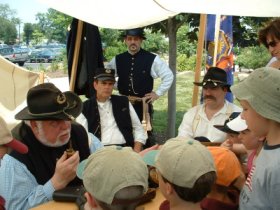
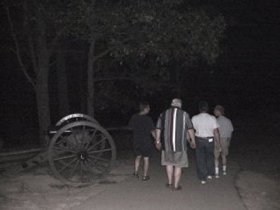
The Park closes at 10 so we headed back to the campgrounds where Autumn treated us to a delicious meal. We talked around the fire late into the night of the Battle, kids, plans for the next day, internet communities, but mostly the Battle. I laid awake a long time trying to put things into perspective.
Wall Ceremony 2002
The Wall Ceremony has continued as a tradition since the 50th anniversary of the Battle of Gettysburg. Veterans of the battle met and were then of course in their 70's and 80's. Confederates decided
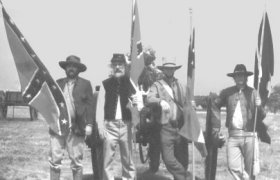 (probably after consuming some adult beverages)
that they would follow the path of Pickett's Charge and finally "Take that wall!". The Federals got wind of the plan and decided to once again defend the Wall. So at 3:00pm July 3, 1913 the Confederate veterans left from the Virginia Monument and made the long walk to the Copse of Trees, not under fire this time, but again in the July heat. How emotional it must have been for them! Once again the Federals were waiting at the wall but this time there was no firing, instead they stood face to face on each side of the wall speechless until one Federal broke the silence saying "Come on over the wall, Brother" and offered a helping hand. The others were soon helped over the wall and the tradition has continued to this day. I am very proud that on my first visit to the Battlefield to have been invited to join in and carry the Battleflag in the Color Guard.
(probably after consuming some adult beverages)
that they would follow the path of Pickett's Charge and finally "Take that wall!". The Federals got wind of the plan and decided to once again defend the Wall. So at 3:00pm July 3, 1913 the Confederate veterans left from the Virginia Monument and made the long walk to the Copse of Trees, not under fire this time, but again in the July heat. How emotional it must have been for them! Once again the Federals were waiting at the wall but this time there was no firing, instead they stood face to face on each side of the wall speechless until one Federal broke the silence saying "Come on over the wall, Brother" and offered a helping hand. The others were soon helped over the wall and the tradition has continued to this day. I am very proud that on my first visit to the Battlefield to have been invited to join in and carry the Battleflag in the Color Guard.
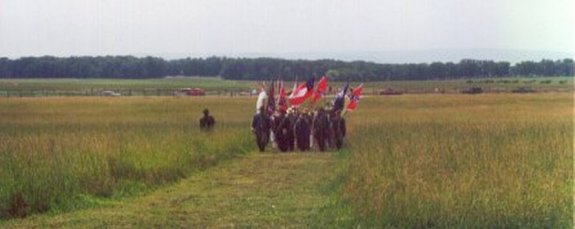
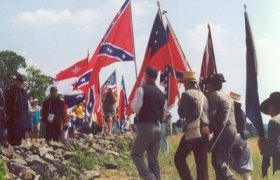
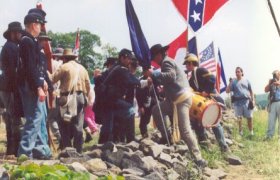
After we had all been helped over the wall
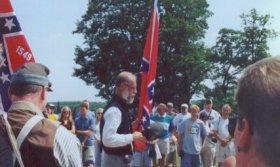 we reassembled and together recited the Pledge of Allegiance. "One Nation under God" was spoken with impromptu emphasis despite (Well, OK, because of) a recent Federal Court ruling. Many of us then met for a remembrance at the monument at the site where General L.A. Armistead was mortally wounded.
we reassembled and together recited the Pledge of Allegiance. "One Nation under God" was spoken with impromptu emphasis despite (Well, OK, because of) a recent Federal Court ruling. Many of us then met for a remembrance at the monument at the site where General L.A. Armistead was mortally wounded.
Evergreen Cemetery
My mentor throughout my visit to Gettysburg, known as JohnBHood also portrays General George Sears Greene as a member of the Civil War Heritage Foundation. He has forty-six ancestors he honors as veterans from both sides of the unpleasantries. On my first morning on Dawn Patrol Hood took me on a tour of Evergreen Cemetery which is the private cemetery on Cemetery Hill that was the site of fierce fighting when the Confederates atttacked from the northeast and for a time held the hill. There are a number of Union graves here and two Confederates were interred despite protests.
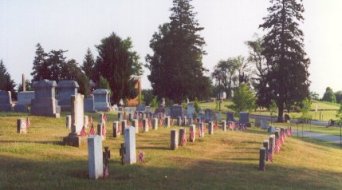
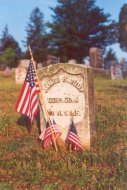
Evergreen is next to the National Cemetery where President Lincoln gave the Gettysburg Address. Lincoln was wrong when he said, "The world will little note, nor long remember, what we say here..." as the Gettysburg Address is one of the best known speeches ever delivered. But Lincoln played an even more important role at Gettysburg. Following the movements of the Armies very closly he made the difficult decision to replace Major General Joseph Hooker with Major General George Meade as Commander of the Army of the Potomac just days before the battle. He was growing impatient and hoped a decisive victory would bring an end to the war, which was to go on for two more years after Gettysburg.
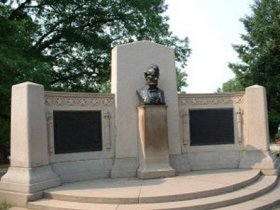
The National Cemetery is right across Taneytown Road from the Visitor Center. I spent one morning looking at hundreds of exhibits and relics and enjoying Cyclorama, a 360-foot panoramic oil painting of scenes from the Battle. Both buildings are scheduled for relocation to less important locations in the Park. Returning the Battlefield to its condition in 1863 is a long-term project and includes removal of woods that have grown up in places that had few trees and purchasing and removing commercial buildings.
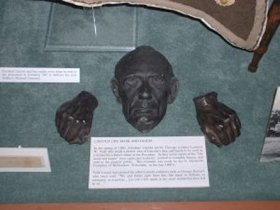
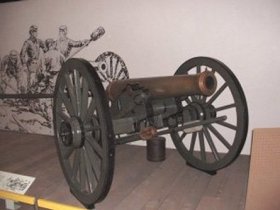
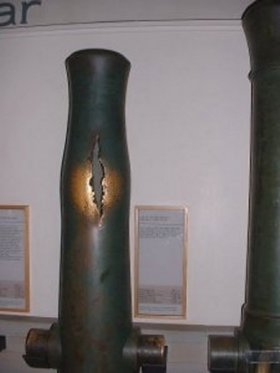
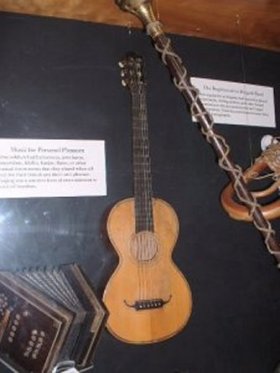
Tours
Gettysburg National Military Park covers some ten square miles so having someone help you around is a must. Park Rangers give free tours on a schedule and Licesensed Battlefield Guides (LBG's) are available for a reasonable fee. Despite high temperatures there were alot of people on the tours ("Send someone back for those stragglers!"). A tour of General Jerome Robertson's Brigade route took us through grassy fields with no shade and through thick muggy woods. We went across the Triangular Field where there was fierce fighting with the Union defending the upper wall. When General Henry Bennington joined the battle the Confederates were able to take and hold Devils Den where Sharpshooters worked quite effectively against officers and men on Little Roundtop.
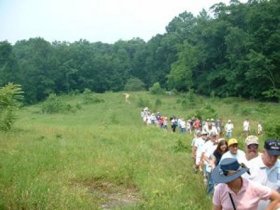
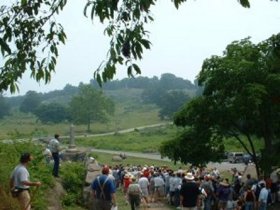
Our guide on this tour, Park Ranger Terry Latcher, was in serious heat exhaustion nearing heat stroke with about five minutes left of the tour. Despite our protests she refused to leave the field until she had finished the tour and then was helped to a vehicle and rushed to the hospital. These people are really dedicated!
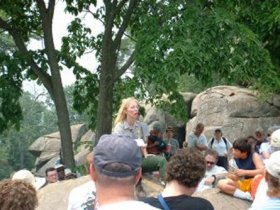
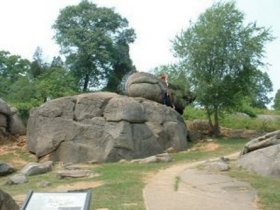
Everyone I met had something about the Battlefield to share. Hiking back through the woods from Devil's Den James aka JHA at MHO showed us the path of the old trolley tracks that ran through the park. He also led us to the foundation of a house that was abandoned by the farmer just before the battle and used as a hospital. Another night on Little Roundtop Autumn aka General Armistead at MHO showed us the Strong Vincent Monument and explained why she thought it was misplaced. This sparked a discussion that ended with a few of us driving to Devil's Den to see if there was a clear line of sight to the monument and to the location Autumn thought matched the written descriptions of the spot. I left feeling that she had a really good point. From each tour I went away wondering "Hey, I wonder where... ?
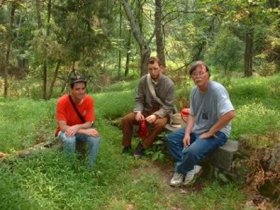
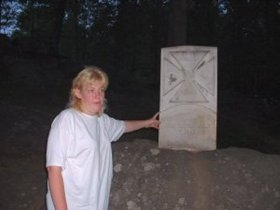
LBG Paul Clarke Cooksey gave us a tour of Iverson's Brigade at Oak Hill, using his recent article in Gettysburg Magazine.
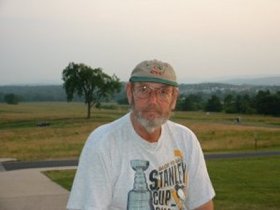
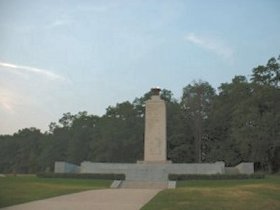
My last evening in Gettysburg LBG Ted took us on a tour of Little Known Areas on the Battlefield. Although it is in the Park one monument has fallen into bad repair due to vandalism. The group, mostly MHO and CWHF members, decided then and there to see to the restoration of the monument by seeking permission from the Park, taking measurements and planning how to get equipment to the remote location. Their concern and enthusiasm is contagious and I am jealous that I won't be there to help.
Ted gave a moving talk comparing Gettysburg and 9/11 and the rebuilding process.
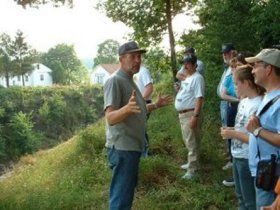
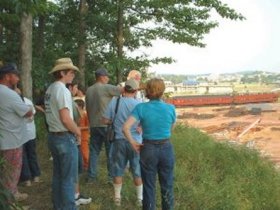
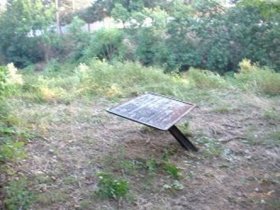
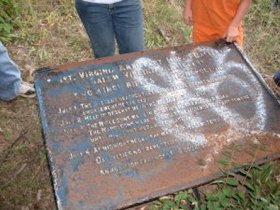
There are some 1300 monuments in the Park. Being in the maintenance business I marvel at the work it must take to keep them looking so good. Major repairwork is being done on the Pennsylvania Monument. There is a running joke about the tourist who asks, "Were any of the monuments damaged during the Battle?" (Others were, "Now is this the place where Lincoln was shot or is it where he is buried?" and "Have you heard about the tourist who asked the fella all decked out as Johnny Reb if he wears underware under those wool pants?") There are some huge monuments and some very impressive statues but the ones that I will remember best are the little flank markers I'd stop at while tramping the field. The ones I sat by and tried to imagine what the officers and men were doing here 139 years ago. Sitting and thinking about how things came to a point that brother had to fight brother. There are no easy answers.

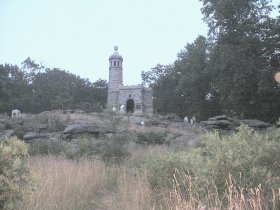
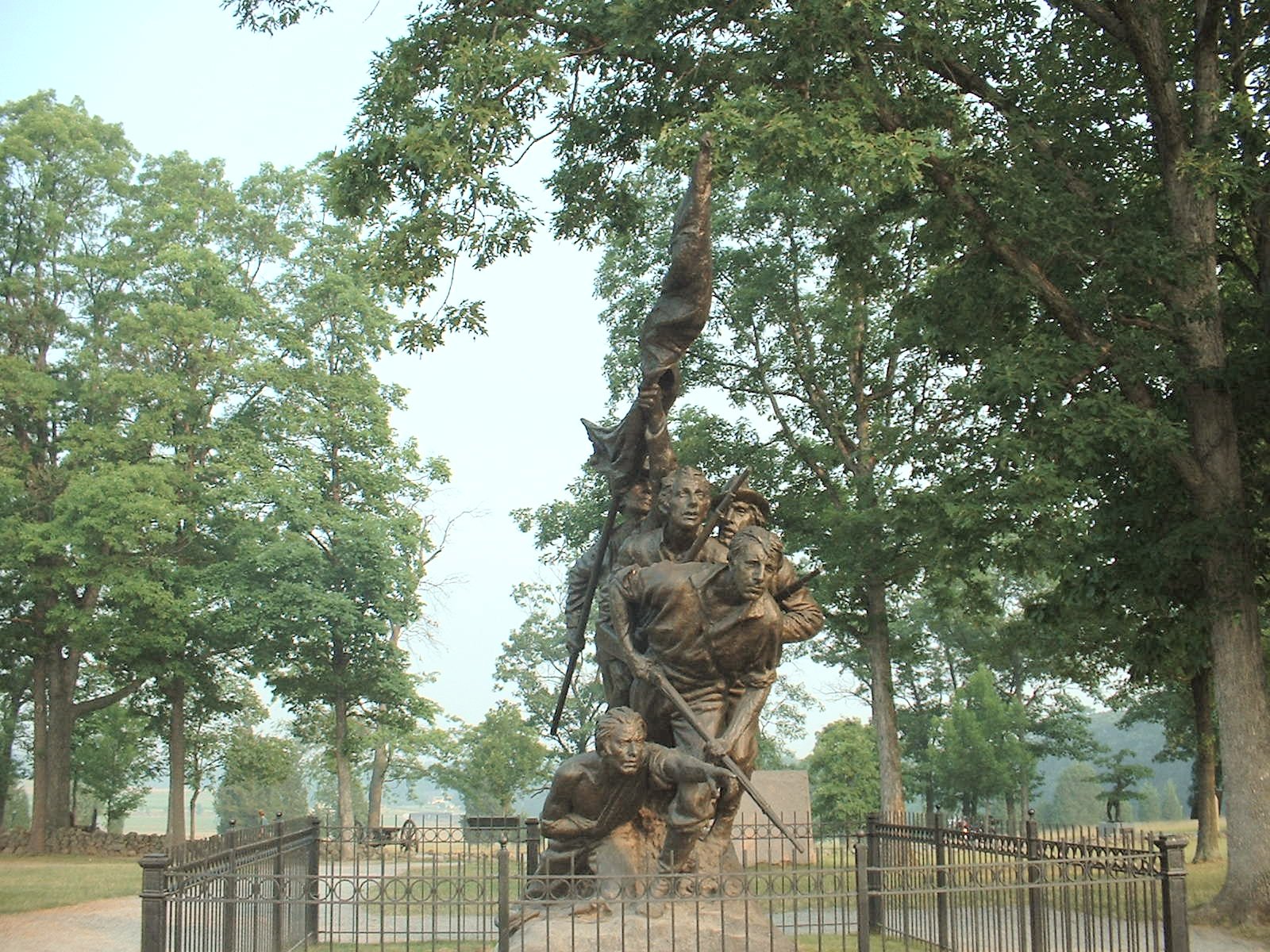
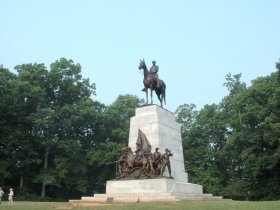
On almost every tour there are buildings that witnessed the Battle. They appear in the photos to be neat, well maintained buildings similar to many throughout this part of Pennsylvania, which they are. But looking closer you see a cannonball stuck in a wall. And you start thinking about the people who were living here at the time, their fears and their losses. "What would I have done if...?"
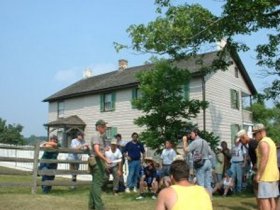
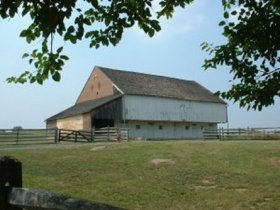
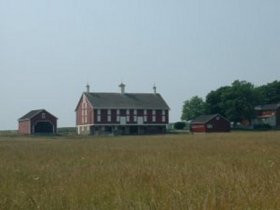
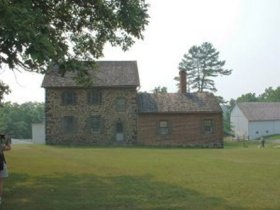
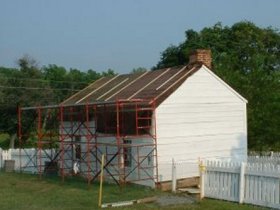
People
The people I met in Gettysburg were of all ages and from all over the country. They had two things in common. All of them were extremely friendly and helpful and they all have a huge desire to preserve the Battlefield and the memory of those who fought here. Some present Living History, some do Re-enactments, all fervently study the strategies of the Armies and the lives of the officers and men who made the plans and carried them out. Or died trying.
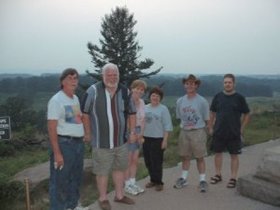
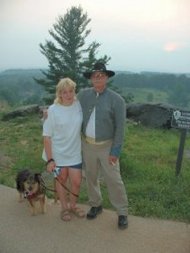
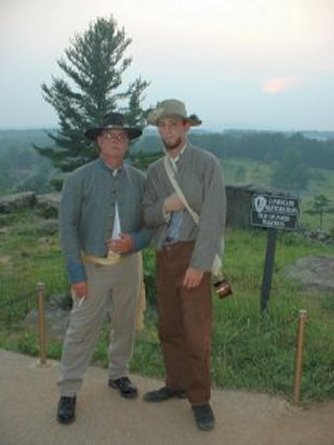
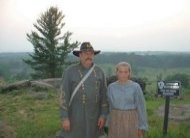

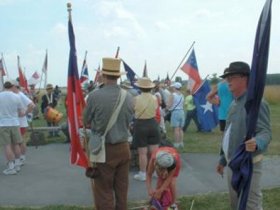
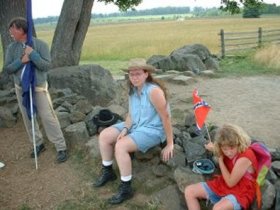
I made one observation that assured me that the memory of those who fought and died here will never fade. It's about children. I met many children and young adults and from the youngest, struggling to walk through tall grass on that hot day of the Wall Ceremony to the high school senior talking of his college plans they had one thing in common. They were all smiling. Polite and respectful. Interested in the history of this place. A young girl called Lil'Bit came up to me with her eyes shining and announced excitedly, "Mamma's gonna take us to the Jenny Wade House tomorrow! Do you know about her?"
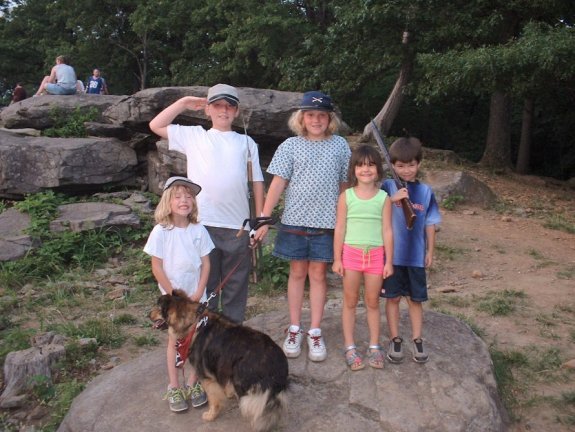
Copyright 2002 Mike Warren All rights reserved